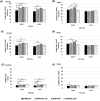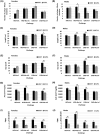Studying host genetic background effects on multimorbidity of intestinal cancer development, type 2 diabetes and obesity in response to oral bacterial infection and high-fat diet using the collaborative cross (CC) lines
- PMID: 33738434
- PMCID: PMC7954829
- DOI: 10.1002/ame2.12151
Studying host genetic background effects on multimorbidity of intestinal cancer development, type 2 diabetes and obesity in response to oral bacterial infection and high-fat diet using the collaborative cross (CC) lines
Abstract
Background: Multimorbidity of intestinal cancer (IC), type 2 diabetes (T2D) and obesity is a complex set of diseases, affected by environmental and genetic risk factors. High-fat diet (HFD) and oral bacterial infection play important roles in the etiology of these diseases through inflammation and various biological mechanisms.
Methods: To study the complexity of this multimorbidity, we used the collaborative cross (CC) mouse genetics reference population. We aimed to study the multimorbidity of IC, T2D, and obesity using CC lines, measuring their responses to HFD and oral bacterial infection. The study used 63 mice of both sexes generated from two CC lines (IL557 and IL711). For 12 weeks, experimental mice were maintained on specific dietary regimes combined with co-infection with oral bacteria Porphyromonas gingivalis and Fusobacterium nucleatum, while control groups were not infected. Body weight (BW) and results of a intraperitoneal glucose tolerance test (IPGTT) were recorded at the end of 12 weeks, after which length and size of the intestines were assessed for polyp counts.
Results: Polyp counts ranged between 2 and 10 per CC line. The combination of HFD and infection significantly reduced (P < .01) the colon polyp size of IL557 females to 2.5 cm2, compared to the other groups. Comparing BW gain, IL557 males on HFD gained 18 g, while the females gained 10 g under the same conditions and showed the highest area under curve (AUC) values of 40 000-45 000 (min mg/dL) in the IPGTT.
Conclusion: The results show that mice from different genetic backgrounds respond differently to a high fat diet and oral infection in terms of polyp development and glucose tolerance, and this effect is gender related.
Keywords: high‐fat diet (42% fat); intestinal cancer; multimorbidity; obesity; oral bacterial infection; type 2 diabetes (T2D).
© 2021 The Authors. Animal Models and Experimental Medicine published by John Wiley & Sons Australia, Ltd on behalf of The Chinese Association for Laboratory Animal Sciences.
Conflict of interest statement
The authors have declared no conflicts of interest.
Figures








Similar articles
-
Unraveling the Host Genetic Background Effect on Internal Organ Weight Influenced by Obesity and Diabetes Using Collaborative Cross Mice.Int J Mol Sci. 2023 May 3;24(9):8201. doi: 10.3390/ijms24098201. Int J Mol Sci. 2023. PMID: 37175908 Free PMC article.
-
Intestinal cancer development in response to oral infection with high-fat diet-induced Type 2 diabetes (T2D) in collaborative cross mice under different host genetic background effects.Mamm Genome. 2023 Mar;34(1):56-75. doi: 10.1007/s00335-023-09979-y. Epub 2023 Feb 9. Mamm Genome. 2023. PMID: 36757430
-
Host Genetics Background Affects Intestinal Cancer Development Associated with High-Fat Diet-Induced Obesity and Type 2 Diabetes.Cells. 2024 Oct 31;13(21):1805. doi: 10.3390/cells13211805. Cells. 2024. PMID: 39513912 Free PMC article.
-
High-fat diet and oral infection induced type 2 diabetes and obesity development under different genetic backgrounds.Animal Model Exp Med. 2023 Apr;6(2):131-145. doi: 10.1002/ame2.12311. Epub 2023 Apr 7. Animal Model Exp Med. 2023. PMID: 37026700 Free PMC article.
-
Assessing the host genetic background effects on type 2 diabetes and obesity development in response to mixed-oral bacteria and high-fat diet using the collaborative cross mouse model.Animal Model Exp Med. 2020 May 17;3(2):152-159. doi: 10.1002/ame2.12117. eCollection 2020 Jun. Animal Model Exp Med. 2020. PMID: 32613174 Free PMC article.
Cited by
-
Towards system genetics analysis of head and neck squamous cell carcinoma using the mouse model, cellular platform, and clinical human data.Animal Model Exp Med. 2023 Dec;6(6):537-558. doi: 10.1002/ame2.12367. Epub 2023 Dec 21. Animal Model Exp Med. 2023. PMID: 38129938 Free PMC article. Review.
-
Unraveling the Host Genetic Background Effect on Internal Organ Weight Influenced by Obesity and Diabetes Using Collaborative Cross Mice.Int J Mol Sci. 2023 May 3;24(9):8201. doi: 10.3390/ijms24098201. Int J Mol Sci. 2023. PMID: 37175908 Free PMC article.
-
A susceptibility gene signature for ERBB2-driven mammary tumour development and metastasis in collaborative cross mice.EBioMedicine. 2024 Aug;106:105260. doi: 10.1016/j.ebiom.2024.105260. Epub 2024 Jul 26. EBioMedicine. 2024. PMID: 39067134 Free PMC article.
-
Potential role of gut microbiota-LCA-INSR axis in high fat-diet-induced non-alcoholic fatty liver dysfunction: From perspective of radiation variation.Curr Res Food Sci. 2022 Sep 27;5:1685-1700. doi: 10.1016/j.crfs.2022.09.022. eCollection 2022. Curr Res Food Sci. 2022. PMID: 36204709 Free PMC article.
-
Genetic and microbial determinants of azoxymethane-induced colorectal tumor susceptibility in Collaborative Cross mice and their implication in human cancer.Gut Microbes. 2024 Jan-Dec;16(1):2341647. doi: 10.1080/19490976.2024.2341647. Epub 2024 Apr 24. Gut Microbes. 2024. PMID: 38659246 Free PMC article.
References
Publication types
MeSH terms
LinkOut - more resources
Full Text Sources
Other Literature Sources
Medical
Molecular Biology Databases

